Themed Museum Tour – Final Project.
Good morning Ladies & Gentleman, I am Naomi and I will be your tour guide for today. If you are apart of this tour today it is because you have taken a special interest in emotions depicted in different forms of art. Throughout history, forms of art have successfully represented emotions and stories in different ways. We see emotions and stories further deepened in details like body language, facial expressions and symbolism. The MET is filled with so much history and beauty. I hope you all enjoy and appreciate the pieces I have selected for you. This tour will be about thirty to forty-five minutes long with an included bathroom break. The MET is a huge building, and it can also be crowded, be sure to stay close to not miss a thing. If you have any questions, feel free to ask.
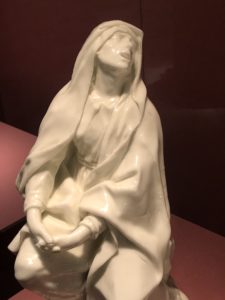
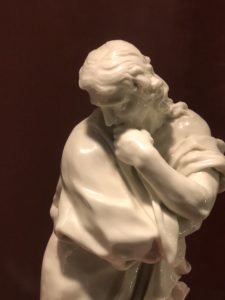
For our first artwork, I want to introduce you to Giuseppe Gricci‘s, The Mourning Virgin and Saint John The Evangelist. This beauty is made of soft-paste porcelain and was made in Naples, Italy in 1744. They’re very small so I want you all to get close to closely see it. As you can tell from the name of this piece, this depicts the Virgin Mary after the death of her son, Christ, and Saint John right next to her. The way Giuseppe portrayed them in their mourning is just impressive and it’s almost like the material that they were made out of captures the mourning even better. We should first focus on the Virgin Mary’s face. Her head is tilted up with her mouth open and her eyes. Then, we also see her body language, she is then propped up on one knee as if her grief has taken over her. When we look over at Saint John, his body is turned away from the Virgin but his head is facing her. Almost as if he is in shock at what had happened and also feels shame. The drapery that is shown almost makes it look like as if they are in movement. The white porcelain makes them look so fragile from their grief. From the emotion on their face to the material that they are done out of, Giuseppe successfully shows the aftermath of Christ’s death that is filled with horror and sorrow from the ones who followed him. In this case, Giuseppe used his material to emphasize the pain St. John and the Virgin Mary felt. This is a perfect first demonstration of emotion and the emotion of a story being shown in art. The sadness is already apparent before you even know any context behind it, and that ladies and gentlemen is very powerful in itself.
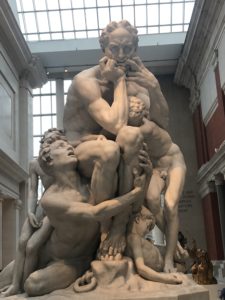
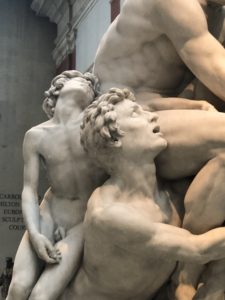
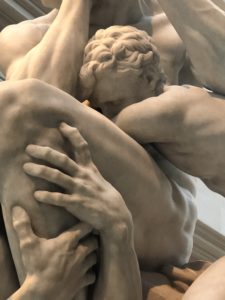
This next masterpiece, is called “Ugolino and His Sons” created by Jean-Baptiste Carpeaux. It is made of Saint-beat Marble and was made in 1865-67, Paris. The name of this artwork is not as revealing as the first work of art that we looked at, so I want you analyze this statue deeply and try your best to look at every single detail. It is very obvious that the man in the front, Ugolino, is in extreme anguish. You can see his knotted body and the way he has his fingers in his mouth. On top of his anguish, it’s almost as if he is indecisive about something. If you focus on the kids around him, his sons, they all are around him either laying on him, hiding in his body, or clinging to him. We see three of them either asleep or maybe even dead and the one who seems to be the older one is the only one looking up at him in some sort of desperation. We see that they are suffering and it comes across very loud and clear. The story behind this statue comes from the epic poem, Dante’s Inferno.Dante encounters Ugolino and his sons locked in a tower after Count Ugolino betrayed his city, Pisa, by giving away fortresses to other towns. When locked away, his sons were complaining about being hungry. When mealtime came, he noticed the door was being nailed. That is when he realized that he would starve in that tower with his sons and other sinners. Driven insane from starvation and seeing his sons slowly die, Count Ugolino was faced with no other choice but to become a cannibal. In some stories, it is said he ate the bodies of his sons and in others it is said he continued to starve. I chose this to be apart of the tour because it is a piece of art that only intensifies the emotions you feel after you hear the story. You experience their emotions before knowing anything about it and pick up on their horror. You notice their facial expressions and their body language but do not know why. Once you find out, you can’t help but feel even more horrified. Carpeaux is just another artist that has managed to envelop you before and after you hear about his inspiration.

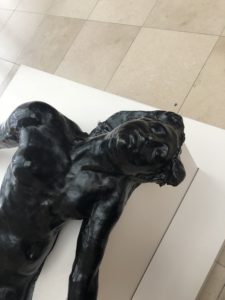
The last statue we will be looking at today is called “The Martyr.“This bronze piece was made by Auguste Rodin in 1898, France. This is another work of art that’s name really gives away the story behind it. However, I want you all to look at her body language and forget about her facial expression. Her body language really gives away her suffering. Whenever we see an artwork of death, we typically see them lied down flat, but here we have something different. We see her arms spread wide, her legs are at a weird angle, and her is almost hanging off the altar she is put on. We can safely conclude that she suffered a great deal of pain before her death. A martyr is someone who is killed for their religious believes and the deaths of the Apostles serve as a testimony that these deaths are very morbid and gruesome. Rodins, “The Martyr” shows that she comes a “symbolic martyr to humanity‘s shard fate. Her youth evokes death‘s universality, her nakedness its indifference, and her isolation the loneliness of the final struggle.“This artwork can compare to Carpeaux‘s “Ugolino and his Sons” because of the decision to express emotion through body language. We hear her tragic ending being told by the way she is positioned on this alter. Although her face does give off a lot of emotion, her body is the statement. The title of this work, her body language, and her bodies symbolism all come into one to tell her tragic tale.
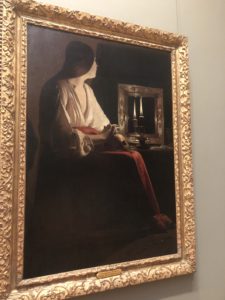
This painting is called “The Penitent Magdalen.” This oil on canvas was made by George de La Tour in 1593-1633, France. Mary Magdalene is known for being the personification of christian fidelity. It is said that Mary Magdalene was a Jewish women who followed Jesus to the death. When Jesus was set to die on the cross and his men abandoned him, Magdalene stayed by his side. She is said to be around him at his tomb and to be the first to announce his resurrection. As you can see, this is the first work of art that does not show a face. Her head is turned away, and we are left to only work with her body and the objects around her. We see a skull on her lap, her hands crossed, a mirror and a candlelight. It is said that Mary Magdalen “renounced the pleasures of the flesh for a life of penance and contemplation.“The mirror is a symbol of”vanity“, the skull on her lap is an “emblem of mortality“, and the candle light most likely stands for her “spiritual enlightenment.” If we moved on to focus on the colors of this painting, the only thing that is lighted from the candle light is the top of her robe. The rest of the painting is filled with shadows and dark colors. We look at this painting and keeping all in the information in mind, we pick up that this an hour of solemnity. This is contrasts from all the statue work we have seen today, but still falls in line, because although we don’t see a face, we are still giving enough objects to grasp the emotion of this painting. Her hands, the skull, the mirror, and the candlelight are enough to give us what we need to understand the sentiment of this painting.
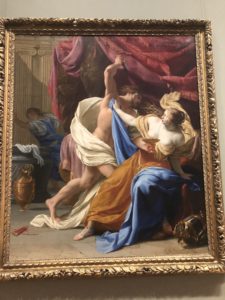
For the last artwork of this tour, This painting is called “The Rape of Tamar.“This oil on canvas was made by Eusatche Le Seur in 1614. This graphic scene tells the story of Tamar being raped by her half-brother Amnon. In the bible, II Samuel 13:1-22, Amnon was a son of David and fell inlove with Tamar. He convinced his friend to help set up a plan which consisted of Amnon faking a sickness and ordering that Tamar attend to him. When they were alone, he turned on her and raped her. After realizing what he had done, he sent her out of his chamber.When Tamar‘s brother, Absalom, realized what had happened, he had Amnon killed. Of course, the face of Tamar and Amnon really gives away the horror and chaos of the scene, but I want you to focus on what is going on in the rest of the painting. From behind them, we see a figure walking away, which we can guess is the friend. He could depict the betrayal that happened here. On the floor, we see objects fallen over. Notice also the movement that is in this picture. The robes of the man in the back are behind him. The white drape of Amnon is also all behind him, only covering his privates, the top of Tamar‘s dress has the same type of movement. Her hair is also in mid-air. Le Seur literally paints this scene in mid-moment right before the rape happens. By doing this, Le Seur accurately shows the chaos of this scene, and he does it in more than one way. He uses all of his canvas to his advantage to set this violent act in motion. The little things do matter in this painting. In taking in all of these things, we feel for Tamar because of the betrayal and the impulsiveness that comes from Amnon. With a painting like this, knowing the story is only the beginning in experiencing the horror of this act.
Well ladies and gentleman, I really hoped you all enjoyed this short tour. It has been a pleasure taking you around the MET and showing you some of my favorites statues and paintings. I hope you were enammored by the different stories and emotions shown just as I was when I first learned of them. Feel free to roam around the rest of the museum and see what other stories you may find. Have a great day and enjoy the rest of your stay.
Rudolf Adis Art Final Project
Rudolf Adis Final Project Annotated Bibliography
Guisepi, R. (Ed.). (n.d.). GREEK AND ROMAN ART. Retrieved December 7, 2018, from http://history-world.org/arthist.htm
This article discusses both the similarities and differences that exist between Ancient Greek and Ancient Roman art. Furthermore, the article also discusses specific artworks from both cultures in order to specify the comparisons and contrasts. For example, one statement made in the article shines light on the Ancient Greeks’ use of marble for their sculptures, as well as their focus on the spirituality and deeper human meaning of their artworks. The Ancient Romans, however, were described as lacking much originality, but they made up for it by improvising and also innovating their artworks (for which they used a sizeable amount of Greek art to model after).
Crawford, N. (2018, September 19). What Are the Differences Between Greek Art & Roman Art? Retrieved December 7, 2018, from https://ourpastimes.com/what-are-the-differences-between-greek-art-roman-art-12279193.html
This article is similar to the previous article in that it also explains both the similarities and the differences in the artwork of the Ancient Greeks and Ancient Romans. For instance, in this article, it is stated that the Ancient Greeks many times represented gods in their work, so as to express their idealistic view on raw physical looks and beauty. The Ancient Romans, on the other hand, used their artwork in order to demonstrate a different main idea, decoration/ornamentation. Furthermore, this article touches on a subject not mentioned in the previous article: the ancient Greeks’ paintings were very limited, whilst the ancient Romans had the upper-hand in painting.
Ambler, J. L. (n.d.). An introduction to ancient Roman architecture. Retrieved December 7, 2018, from https://smarthistory.org/roman-architecture/
In this online source, the main topic focused on was the architecture in Ancient Rome, as well as the differences in architecture that exist between the Ancient Romans and Ancient Greeks. Namely, the architecture of the ancient Greeks revolved around the post-and-lintel system. The architecture of the ancient Romans, however, differed in that it focused mostly on concrete, arches, and vaulting. Along with this, the article describes a number of famed ancient Roman architects, as well as the architectural pattern that most Roman cities were focused on: the forum, which is a large open plaza that is surrounded by important buildings, as per the online source.
Greek and Roman Art. (n.d.). Retrieved December 7, 2018, from https://www.metmuseum.org/about-the-met/curatorial-departments/greek-and-roman-art
In this online source, it is not so much wording that helps distinguish the source topic as it is the images of ancient Greek and Roman paintings that do. The reason why this is such a key online source is because its organization and display of artworks that correlate with their respective culture (either Ancient Greek or Ancient Roman) is clear enough to allow the reader to self-evaluate the distinctions between the artworks of the ancient Greeks and the ancient Romans.
Hemingway, C. (2003, October). Architecture in Ancient Greece. Retrieved December 7, 2018, from https://www.metmuseum.org/toah/hd/grarc/hd_grarc.htm
Finally, in this online source, the architecture of ancient Greece in specific is exemplified and expanded upon. This makes it easy to intake the information, and differ it from architectural information on ancient Rome, as seen in the aforementioned articles. In short, two principal order are stated as having entirely influenced the ancient Greek architecture that still remains wildly ubiquitous even to this day. These two principal orders are the Doric and the Ionic orders, which both differ in their general ideas of architectural design, such as the frieze, the cornice, the architrave, and etc.
Final Project: option 2
 Loading...
Loading...
Final Project: annotate bibliography
 Loading...
Loading...
FINAL PROJECT: “The Art of Deceit”
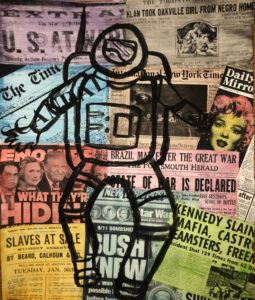
“Art of Deceit” by Kristine Veras
In class before we spoke on the period of Roman Portraiture, and how Art wasn’t always accepted for reasons of it being viewed as deceitful or for allowing too much freedom of thought or expression, and eventually Verism, a form of realism art, started being incorporated into Art more. Art was looked down upon and instead, more realistic things such as government, philosophy etc were seen as ideal. If you look at the piece that I created, it’s a bunch of headlines surrounding some of the biggest political scandals in the background, each painted a different color to stand out not only as a whole but amongst one another so that the viewer can draw individual attention to each headline. In the foreground, here is an astronaut, the size of the entire canvas; therefore it’s relatively large compared to the headlines to also stand out. The purpose of the Astronaut being that one of the most relevant scandals, mysteries, “conspiracy theories” is surrounding whether the Moon landing was staged or not. When creating the piece I really wanted to capture the irony behind Art being unaccepted for being “Deceitful”, when really one of the largest deceits, yet one of the most present and active ones in our lives, is the government. There’s also an irony in how Art itself can be a political statement about political statements and maybe that’s why it wasn’t accepted, it was seen as a potential danger. And that is the art of deceit.
Final Essay Annotated Bibliography (Second Topic)
Heilbrunn Timeline of Art History
https://www.metmuseum.org/toah/works-of-art/18.2.4/
Heilbrunn Timeline of Art History
https://www.metmuseum.org/toah/works-of-art/05.30/
Heilbrunn Timeline of Art History
https://www.metmuseum.org/art/collection/search/198766
These 3 pieces offer history to my project. With these sources I can better understand the conditions in which these pieces were built and why they were built. It gives us explanations on who these people were and what they have done to get statues built of them. It also helps because each one of these pieces of work come from a different region so we have more pieces to compare from for our project to see differences and similarities.
Roman Portrait Sculpture: Republican through CONSTANTINE
https://www.metmuseum.org/toah/hd/ropo/hd_ropo.htm
This post gives a lesson on the importance of sculptures and it talks about how they come to fruition. This tells us about how these statues were typically made to celebrate a noted military achievement, usually in connection with an official triumph, or to commemorate some worthy political achievement, such as the drafting of a treaty. We also learn about how bad emperors usually did not get one or they got their sculptures destroyed.
Roman Egypt Essay
https://www.metmuseum.org/toah/hd/regy/hd_regy.htm
This was is really important because it ties a connection between the Roman and the Egyptian pieces of work and how they are influenced from each other. Rome’s rule over Egypt officially began with the arrival of Octavian in 30 B.C., following his defeat of Marc Antony and Cleopatra in the battle at Actium. It talks about how once Rome took over a new fascination with its ancient culture became influential. Obelisks and Egyptian-style architecture and sculpture were installed in Roman fora. This led to the changing and development of a new Egyptian style of sculptures and a new Roman style.
Final Project: The True use and Influence of Architecture Throughout Societies
From the 20th Century to modern day civilization, societies from all around the globe have constantly endured their share of hardships. For example, in the ’40s the world experienced the horrific nature of The Holocaust. After years of fighting with the Germans, the end result was an utter catastrophe. Buildings were destroyed, homes turned to ash, and millions murdered. It took decades to rebuild what was once lost, but yet the job was finished wholeheartedly. Due to architects and their projects, new buildings were built and as everything was being brought back slowly, hope was restored to the people. After WWII, comes the rise of the Cold War. As a result of the Cold War, economies plummeted and certain societies were destroyed. For example, the society of Yugoslavia was in shambles. However, the Utopian project was created to rebuild through architecture and restore the light in the souls of the people. Nothing more is desired than to live harmoniously amongst each other with the eradication of violence. That is what architecture has and is continuously trying to provide society with. In its purest form, architecture provides a certain influence on society through its intersection with individualistic creativity. This concept of art is used worldwide in an ongoing attempt to create drastic changes in modern civilization and in the minds of the general public. Through the architectural genius of Bodys Isek Kingelez “City Dreams,” the project known as “Toward a Concrete Utopia: Yugoslavia,” and from public architecture such as the fallen Twin Towers (now known as One WTC), the world is in an attempt to move towards a better future.
Bodys Isek Kingelez is a self-taught Congolese artist who decided to bring a pure fantasy into a reality. His “City Dreams” collection consists of vibrant and elaborate cities that are made from paper and cardboard (Wiesenberger). Kingelez dedicated his buildings to cities, companies, countries, civic infrastructure, and intergovernmental organizations (Wiesenberger). Much of his work actually represents the city and country in which he grew up in, as well as, future utopian communities. For example, the project known as Ville De Sete 3009 is a projection of a fictive metropolis (Wiesenberger) where doctors and police are not needed (MoMA).

Other exceptional and profoundly artistic pieces that Kingelez created was the U.N. (1995) and the Scientific Center of Hospitalisation the SIDA (1991) (MoMA). The U.N. piece was created to “attest the organization’s global peacekeeping efforts and the artist’s own sense of civic responsibility” (MoMA). It represents a peaceful future, in which nations from around the world come together to create a united society. No wars, just peace. The Scientific Center of Hospitalisation of SIDA was created in response to the spread of AIDS in his country. Kingelez himself was quite intrigued with world events and social issues (MoMA) which acted as a prime inspiration in his creations. “His work explores urgent questions around urban growth, economic inequity, how communities and societies function, and the rehabilitative power of architecture—issues that resonate profoundly today” (MoMA). In the artist’s words, he imagined “a better, more peaceful world” (MoMA). People who walk by this exhibit in the Museum of Modern Art hardly recognize the purity it brings and the hope it establishes. When I first experienced this exhibit, I was in awe. A sudden wave of serenity washed over me, and in my mind, I pictured a better future filled with peace.
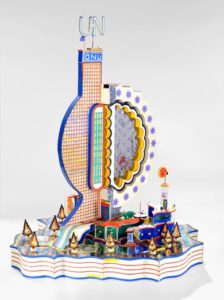
Architecture not only inspires, but it transforms the world as well. Societies have endured countless wars and total destruction, but what brings it back from the brink is the use of architecture. The Republic of Yugoslavia is a perfect example of the true use of architecture. After the Cold War, everything was in shambles. However, architects who participated in the Concrete Utopian Project from 1948-1980 “responded to contradictory demands and influences, developing a postwar architecture both in line with and distinct from the design approaches seen elsewhere in Europe and beyond” (MoMA). This project explores “themes of large-scale urbanization, technology in everyday life, consumerism, monuments and memorialization, and the global reach of Yugoslav architecture” (MoMA). Without these wonderful artistic minds, Yugoslavia would not be living up to its own potential. Some might say architecture nowadays is all about becoming the new face of a magazine (MoMA/Youtube). They wouldn’t be wrong. However, those who would say that are not entirely correct. Yes, architecture is a competition, but it is also the foundation of the future. Without architecture, the world would be archaic. It’s beautiful to see what was once destroyed, to be back up on its feet again. Citizen of Yugoslavia never would have believed that their city would be restored back to glory.

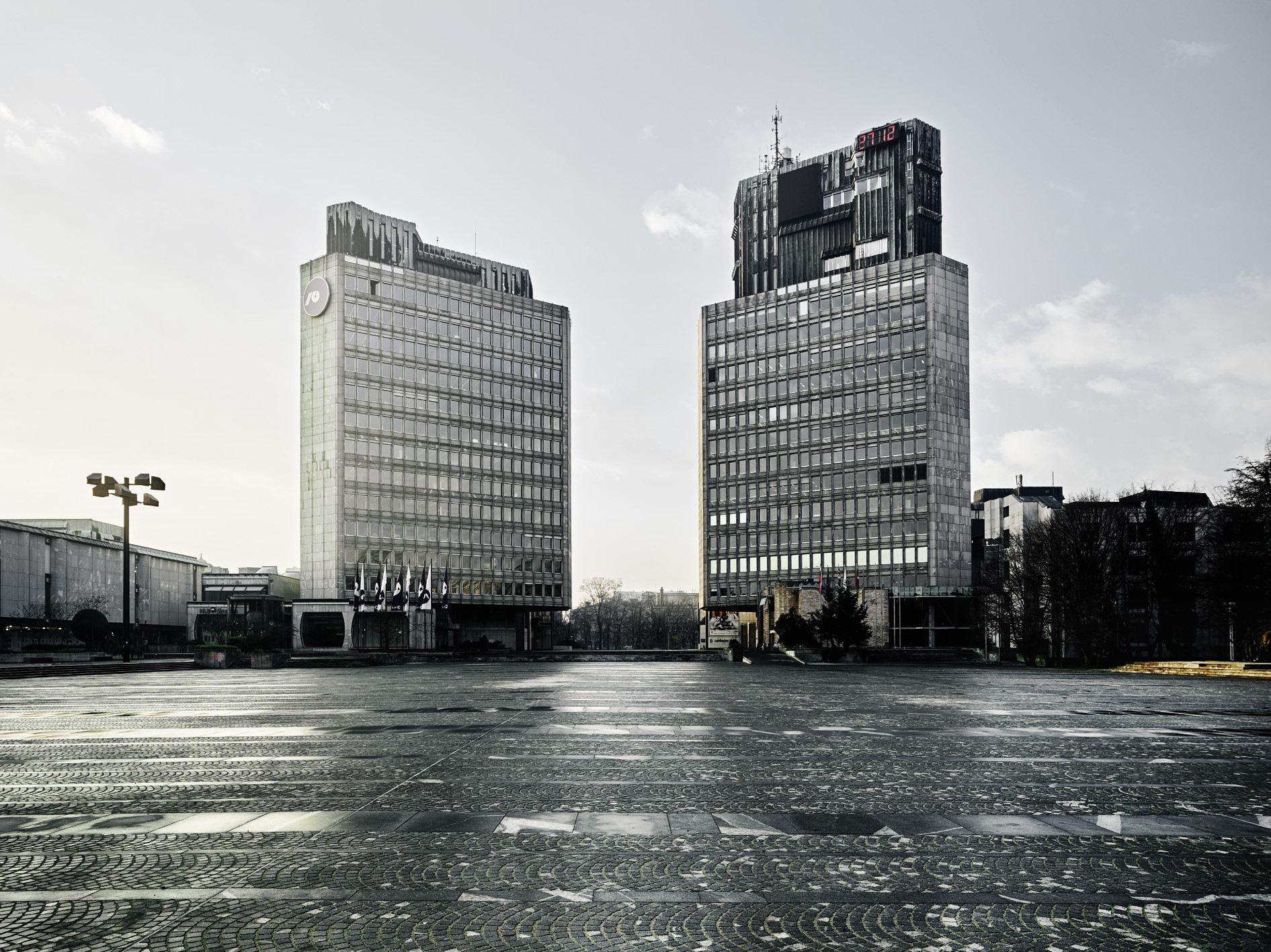
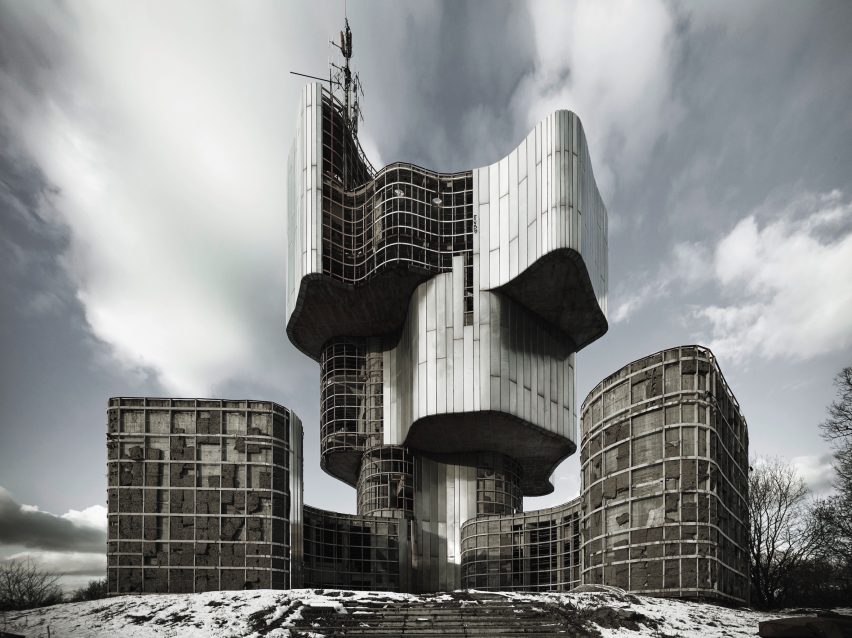
![]()
These structures represent a glowing new world. One in which everyone can enjoy and have stored in memory.
Now, one of the most prominent pieces of public architecture, in my opinion, is the fallen but never forgotten Twin Towers. On September 11, 2001, a horrific act of terrorism flew two planes into the Twin Towers in New York City. Before these towers were destroyed, the architectural brilliance that went into it is beyond anyone’s wildest dreams. “Manhattan’s World Trade Center was a triumph of human imagination and will. Completed in 1973, the towers stood at 110 stories each, accommodating 50,000 workers and 200,000 daily visitors in 10 million square feet of space” (History.com). It was New Yorks most famous tourist attraction and symbolized “America’s–steadfast devotion to progress and the future” (History.com). If someone were to visit New York, from a plane these towers could be seen. That is when someone would know they are in New York City. Some would even use these towers to orient themselves in the hustle and bustle of the city. The World Trade Center was a “concept of world peace through trade” (History.com). It was not only a symbol of the future, but it was a symbol of triumph as well. Even though the towers are gone, a new World Trade Center stands in its place. It stands mighty and strong, commemorating the fallen and showing the world that America and New York cannot be brought down. There is resiliency in the architecture of this building and hope of a new age.

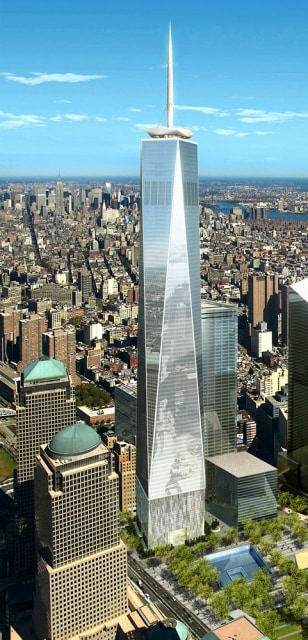
I chose architecture as my topic because it represents something unique for every individual. For one it might represent hope, for another, it could represent bravery or courage. No matter the representation, architecture affects every person differently. It’s important to understand the true nature and effect it has on society because, without this piece of creativity and art, society becomes uncultured. Through the architectural genius of Bodys Isek Kingelez “City Dreams,” the project known as “Toward a Concrete Utopia: Yugoslavia,” and from public architecture such as the fallen Twin Towers (now known as One WTC), the world is in an attempt to move towards a better future.
Bibliography
Art, The Museum of Modern, director. Toward a Concrete Utopia: Architecture in Yugoslavia, 1948-1980. YouTube, YouTube, 10 July 2018, www.youtube.com/watch?v=M2S0bBTHu-8.
“Bodys Isek Kingelez: City Dreams.” Lee Bontecou. Untitled. 1959 | MoMA, www.moma.org/calendar/exhibitions/3889?locale=en.
“Toward a Concrete Utopia: Architecture in Yugoslavia, 1948– 1980.” Lee Bontecou. Untitled. 1959 | MoMA, www.moma.org/calendar/exhibitions/3931
Wiesenberger, Robert. “Bodys Isek Kingelez: City Dreams.” Art Papers, www.artpapers.org/bodys-isek-kingelez-city-dreams/.
“World Trade Center .” History.com, A&E Television Networks, www.history.com/topics/landmarks/world-trade-center.
Final Project Outline/Background

Date:ca. 1500–1525
Culture:French
Museum: Metropolitan Museum of Art
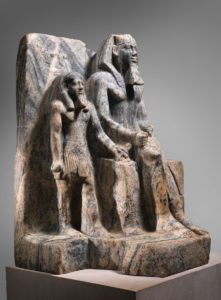
Date:ca. 2458–2446 B.C.
Geography:From Egypt
Museum: Metropolitan Museum of Art
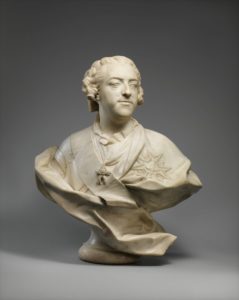
Artist:Jean-Baptiste Lemoyne the Younger (French, Paris 1704–1778 Paris)
Date:1757
Culture:French
Museum: Metropolitan Museum of Art

Date:A.D. 251–253
Culture:Roman
Museum: Metropolitan Museum of Art

Date:ca. 1250
Geography:Made in Burgundy, France
Culture:French
Museum: Metropolitan Museum of Art
Something that is within all the artworks above is the normality of the postures and facials expressions of the subjects used to covey. These are all pieces that are of royals and I chose this because I wanted to see how different types of cultures treat their rulers and how they represent them and preserve their memory through their art.


